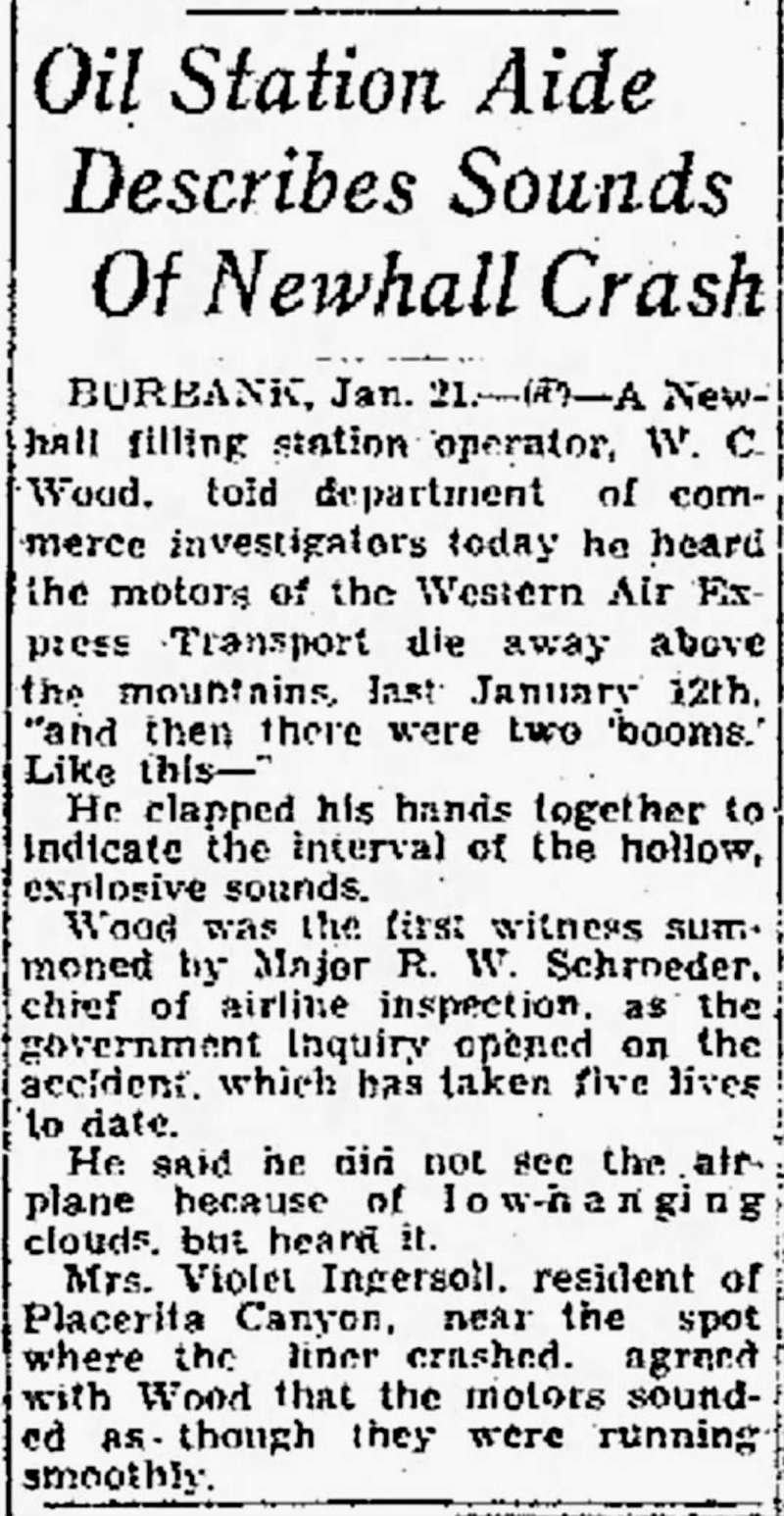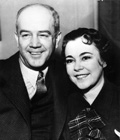Another Airplane Crash Kills 2.
Plane With 13 on Board Hits Iron Mountain.
The Newhall Signal and Saugus Enterprise| Thursday, January 14, 1937.
Webmaster's note: After this report was published, three more people succumbed to their injuries, for a total of five casualties.
During the drizzling rain Tuesday, John Wood, caretaker at the Dulin ranch three miles east of town, heard an airplane motor begin to sputter, and stop suddenly. This was followed by a loud crash sounding like an explosion. Mr. Wood at once came to Newhall and reported to the Sub-Station, and then the news of the crash of the airliner on top of Stone mountain was flashed to the world.
The crash came at 11:15 as Pilot W.W. Lewis attempted to take the plane to the Burbank airport in fog. He had "lost the beam" when he got to the east side of it, and was flying at some 2,000 feet, having already flashed his signal for the passengers to get ready for landing. The ceiling here was 1,000 feet, which is none too safe anywhere, but would have permitted an emergency landing at the Saugus port. Suddenly the mountain loomed before him, and Lewis with lightning-like thought, shut off the motors and "pancaked" on the side of the mountain, only a short distance from the lockout station. The thirteen occupants of the plane were thrown in a heap, and one, James A. Braden, Cleveland, Ohio was instantly killed. Martin Johnson, world famous traveler and explorer, was badly hurt, dying Wednesday morning. All the rest of the group received severe injuries, among them Mrs. Johnson, wife of the explorer, C.T. Owens, co-pilot, and A.L. Loomis, Omaha, Nebraska. Arthur S. Robinson, of Rochester, N.Y., the least hurt of all, worked his way down the mountain toward Olive View Sanitarium, where he met a rescue party of all the doctors of the Sanitarium, the crash having been reported there by some patients in an outside cabin, high on the mountainside.
The first reports here placed the crash in Placerita Canyon, and a large party of officers, reporters and others rushed out that way, planning on walking, or wading to the wreck. After the correct location was learned, systemic arrangements were made to get to the plane, but the rain, which continued all day, hampered operations, and it was not until past midnight that the victims were finally brought down from the south side by mule teams and buckboard. A tractor was also utilized to carry some of them it was stated.
Besides those named above, the other passengers and crew members were: Herbert Hulse, Peru, Ill.; E.E. Spencer, Chicago; T. Tillinghast, Hartford, Conn.; Miss Leta James, Los Angeles; R.T. Anderson, Atlantic City, N.J.; Stewardess Esther Jo Connor, Glendale. Pilot Lewis was also badly hurt, but recovered in time to stand guard over the mail until he turned it over to rescuers.
Hundreds of people from Newhall and all around, rushed to the nearest possible place to get to the wreck, but most of them gave it up. Curiosity seekers, however, kept coming, all afternoon, and through the night. Hundreds of reporters were everywhere, and some of them must have had strange experiences.
The wreck is plainly visible from Newhall, and all day Wednesday, telescopes and field glasses were used to view the scene. The plane lies exactly between the lookout tower and Newhall, and is very easily located.
Lewis was in a fog bank when the plane crashed. There was no wind, and at the time of the crash it was drizzling rain, which was probably turning to snow on the mountain, but not when the crash came.
Pierre Daries, Forestry and Fire Warden, organized the rescue party to go up the trail, but only horses or mules could make the trip. It was much easier to get down off the hill than to get up with any adequate means of transportation, which accounts for the long delay in rescuing the victims of the crash. The spot could be reached from almost any direction on foot, but by other means was not so easy.

Click to enlarge.
|
Oil Station Aide Describes Sounds of Newhall Crash.
Associated Press | As Published in the The Fresno Bee / The Republican | Thursday, January 21, 1937.
Burbank, Jan. 21 — (AP) — A Newhall filling station operator, W.C. Wood, told department of commerce investigators today he heard the motors of the Western Express Transport die away above the mountains last January 12th, "and then there were two 'booms.' Like this —"
He clapped his hands together to indicate the interval of he hollow, explosive sounds.
Wood was the first witness summoned by Major R.W. Schroeder, chief of airline inspection, as the government inquiry opened on the accident, which has taken five lives to date.
He said he did not see the airplane because of low-hanging clouds, but heard it.
Mrs. Violet Ingersoll, resident of Placerita Canyon, near the spot were the liner crashed, agreed with Wood that the motors sounded as though they were running smoothly.
News story courtesy of Lauren Parker.

Click to enlarge.
|
Crash Pilot in Plea for Radio.
Associated Press | As Published in the San Bernardino County Sun | January 22, 1937.
Burbank, Jan. 21 — W.W. Lewis, pilot of the airliner which crashed in Placerita canyon last Jan. 12 said today the localizer radio beam which would have guided him safely over the mountains "never came on."
Strapped to his bed in Good Samaritan hospital, Lewis was questioned by Major R.W. Schroeder of the Federal department of commerce, who is conducting an investigation of the crash. Lewis did not know that five of the 13 persons who were aboard the plane have died.
"I came in on the (direction) beam to Saugus, flying perhaps 25 feet above the highest clouds," he said. "I began to talk to the airport and tell them I would be in at 11:06 a.m.
"The ship didn't want to go down. Because of the wind currents I began to shove her around pretty heavy. The plane was churning all over the sky."
Lewis said he called the airport here, asking that the localizer beam be flashed toward his ship.
"The weather was getting worse. I began to get nervous and busted in to tell KBLA to get off the air," he related.
KBLA is the airport control tower. When radiomen are talking to aircraft aloft, it was explained, the localizer cannot function.
"Finally," said Lewis, "they came back with the call, 'clear on in.'"
"But that time I knew I was getting in bad shape. I poked my head up over the ice on the windshield and saw the ground. I saw two bushes, one higher than the other. That's all I remember. The rest was just instinct."
News story courtesy of Lauren Parker.












